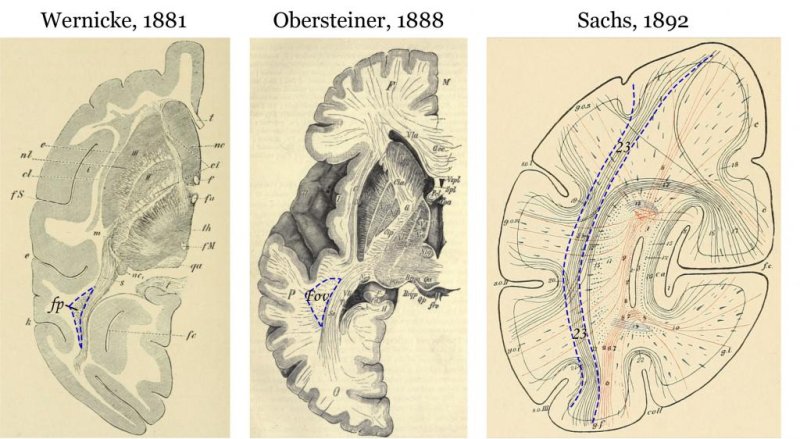The first images of the vertical occipital fasciculus, a drawing by Wernicke’s published in 1881. (University of Washington)
STANFORD, Calif., Nov. 20 (UPI) -- A region of the brain known as the vertical occipital fasciculus, or VOF, was first identified in the latter half of the 19th century, but not long after its discovery, it went missing. It didn't literally disappear -- only literarily.
For more than 100 years, the VOF was absent from scientific literature, and modern scientists failed to recognize the snake-like neural pathway as a distinct region of the brain.
But now, a team of researchers from Stanford University and the University of Washington are looking to resurrect the pathway after happening upon the unidentified region while studying how the human brain processes visual information.
"It was this massive bundle of fibers, visible in every brain I examined," neurologist Jason Yeatman, a researcher Washington's Institute for Learning & Brain Sciences, explained in a recent press release. "It seemed unlikely that I was the first to have noticed this structure; however, as far as I could tell, it was absent from the literature and from all major neuroanatomy textbooks."
But Yeatman and and Kevin Weiner, a Stanford postdoctoral researcher, happened upon a book which mentioned this unique structure while scanning the pages of old brain atlases in the basement of the Stanford Medical Library.
"Kevin found an atlas, written by Carl Wernicke near the turn of the (20th) century, that depicted the vertical occipital fasciculus," Yeatman said. "The last time that atlas had been checked out was 1912, meaning we were the first to view these images in the last century."
As it turns out, Wenicke's discovery of the VOF had been quickly dismissed because it violated a central law of brain anatomy established by another famous neurologist (and Wenicke's mentor), Theodor Meynert, who said major neural pathways only traveled from front to back, never vertically.
But as new MRI imaging reveals, significant pathways do travel up and down, and the VOF is one of them. The pathway begins in the occipital lobe, a region toward the back of the brain that is vital to the visual processing system. The neural fibers spread out connecting the occipital lobe with other brain regions seeing and locating objects
"We believe that signals carried by the VOF play a role in many perceptual processes, from recognizing a friend's face to rapidly reading a page of text," Yeatman said.
Yeatman and Weiner, whose work is detailed in the latest issue of the Proceedings of the National Academy of Sciences, have made a VOF-finding algorithm available to other scientists who want to locate and observe the region.















